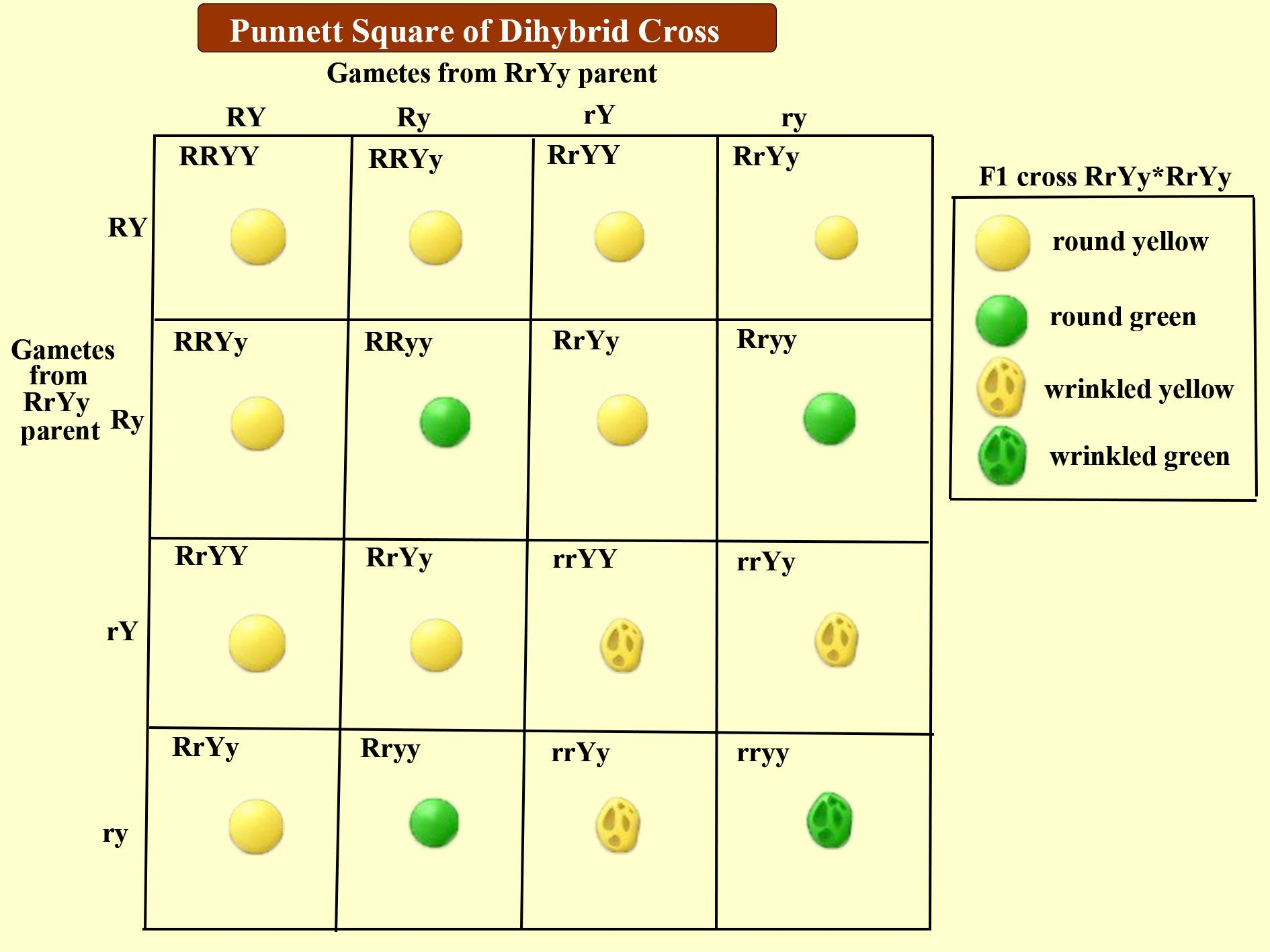
The phenotypic ratio in the dihybrid cross is
(a)${ 9: }{ 3: }{ 3: }{ 1 }$
(b)${ 9: }{ 2: }{ 2: }{ 1 }$
(c)${ 7: }{ 2: }{ 2: }{ 3 }$
(d)${ 5: }{ 3: }{ 3: }{ 2 }$
Answer
572.1k+ views
Hint: The phenotypes obtained were out of the sixteen possible allele combinations obtained by crossing the male and the female gametes where two traits are taken into consideration.
Complete answer:
A dihybrid cross is a cross between two different genes of two different traits. Three are two types of traits, one is the dominant trait and the other is the recessive trait. The phenotypic ratio obtained in the dihybrid cross is ${ 9: }{ 3: }{ 3: }{ 1 }$. The phenotypic ratio represents a relationship between the different physical characteristics.
The dihybrid cross involves the two traits (e.g. R and Y) having two different alleles (e.g. R and r, or Y and y) to combine together for crossing their genetic information. The parents after gametes formation will form four gametes each (e.g. RY, Ry, rY, and ry). This cross is shown using the Punnett square.
The total offspring produced were sixteen having their different allele combinations. These combinations result in the production of nine offspring having both the dominant phenotypes, the six offsprings produced were having one dominant phenotype and one recessive phenotype, while the last one offspring produced consists of both the recessive phenotypes. The complete dominant and recessive phenotype display homozygous condition while those combinations which have both the dominant and the recessive alleles display heterozygous condition.
The rule of meiosis applied in the dihybrid cross is explained in Mendel's first and second laws, which are called the Law of Segregation and the Law of Independent Assortment.
So, the correct answer is ‘${ 9: }{ 3: }{ 3: }{ 1 }$’.
Note: The Law of Segregation applies when the two individuals are in heterozygous condition. The offspring is different in genotype and phenotype both from their parents which depict the characters of the grandparents. The Law of independent assortment states that alleles of different traits are inherited independently from the other. The gamete produced due to independent assortment will have a mixture of the chromosomes of both the organisms.

Complete answer:
A dihybrid cross is a cross between two different genes of two different traits. Three are two types of traits, one is the dominant trait and the other is the recessive trait. The phenotypic ratio obtained in the dihybrid cross is ${ 9: }{ 3: }{ 3: }{ 1 }$. The phenotypic ratio represents a relationship between the different physical characteristics.
The dihybrid cross involves the two traits (e.g. R and Y) having two different alleles (e.g. R and r, or Y and y) to combine together for crossing their genetic information. The parents after gametes formation will form four gametes each (e.g. RY, Ry, rY, and ry). This cross is shown using the Punnett square.
The total offspring produced were sixteen having their different allele combinations. These combinations result in the production of nine offspring having both the dominant phenotypes, the six offsprings produced were having one dominant phenotype and one recessive phenotype, while the last one offspring produced consists of both the recessive phenotypes. The complete dominant and recessive phenotype display homozygous condition while those combinations which have both the dominant and the recessive alleles display heterozygous condition.
The rule of meiosis applied in the dihybrid cross is explained in Mendel's first and second laws, which are called the Law of Segregation and the Law of Independent Assortment.
So, the correct answer is ‘${ 9: }{ 3: }{ 3: }{ 1 }$’.
Note: The Law of Segregation applies when the two individuals are in heterozygous condition. The offspring is different in genotype and phenotype both from their parents which depict the characters of the grandparents. The Law of independent assortment states that alleles of different traits are inherited independently from the other. The gamete produced due to independent assortment will have a mixture of the chromosomes of both the organisms.

Recently Updated Pages
Master Class 12 Business Studies: Engaging Questions & Answers for Success

Master Class 12 Economics: Engaging Questions & Answers for Success

Master Class 12 English: Engaging Questions & Answers for Success

Master Class 12 Maths: Engaging Questions & Answers for Success

Master Class 12 Social Science: Engaging Questions & Answers for Success

Master Class 12 Chemistry: Engaging Questions & Answers for Success

Trending doubts
What is meant by exothermic and endothermic reactions class 11 chemistry CBSE

Which animal has three hearts class 11 biology CBSE

10 examples of friction in our daily life

One Metric ton is equal to kg A 10000 B 1000 C 100 class 11 physics CBSE

1 Quintal is equal to a 110 kg b 10 kg c 100kg d 1000 class 11 physics CBSE

Difference Between Prokaryotic Cells and Eukaryotic Cells




